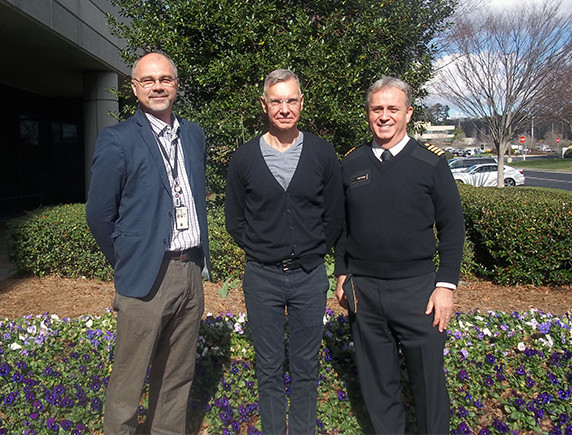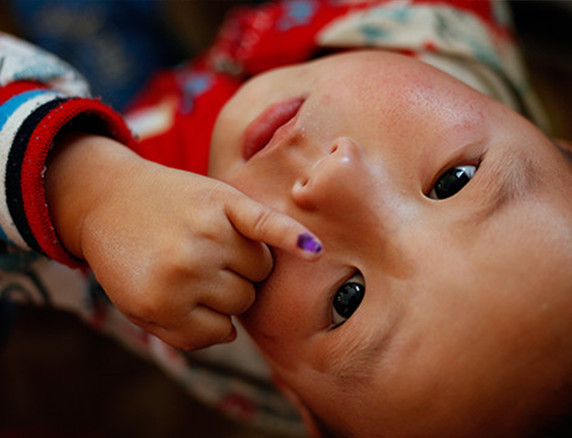What is measles?
Measles is far too common, but unlike a common cold, this infection can be fatal. Measles virus spreads through the air when an infected person coughs or sneezes and can seriously affect children and adults. Symptoms can include runny nose, fever, watery eyes, skin rash; complications can include pneumonia, encephalitis and death. Worldwide, it is estimated that over 300 children die from measles complications each day. In the United States, 667 measles cases were reported to CDC in 2014—the largest number of cases in a year since 1994. These cases resulted from people infected overseas bringing the virus into the US.
The last endemic case in the US was in 2000 and endemic measles was officially eliminated from the Western Hemisphere in 2016. Unfortunately, cases detected in the US represent only a tiny sliver of the estimated 10 million people affected by measles around the world each year. Thankfully, measles can be prevented by a safe and effective vaccine that has been available for over 50 years.
The global fight against measles is serious business for Robb Linkins, Mark Papania, and Jim Goodson, epidemiologists in the Global Immunization Division (GID) at CDC. Along with staff at WHO, UNICEF, the United Nations Foundation, and the American Red Cross—other partner agencies of the Measles and Rubella Partnership (M&RP) of which Linkins is chair—they work tirelessly to help get vaccine to the 130 million children born each year, before they are exposed to this deadly disease.
“Measles moves fast; we’ve got to move faster” says Papania, lead of the Measles Elimination Team in GID. Their strategies start with delivery of two doses of measles vaccine to all children. Measles elimination requires strong immunization programs that can vaccinate all children on-time, regardless of where they live, and much of the global fight focuses on strengthening immunizations systems to be able to complete this strategy. Other key strategies include conducting large supplemental vaccination campaigns to give vaccine to children missed by the routine systems, and building surveillance systems to detect and respond to measles outbreaks as quickly as possible to limit the number of measles cases.
Linkins, chief of the Accelerated Disease Control and Vaccine Preventable Disease Surveillance Branch in GID, says, “CDC provides the technical muscle for the M&RP by providing technical assistance though deploying Atlanta-based staff to high measles-burden countries, seconding staff long-term to partner agencies, and supporting the Global Measles and Rubella Laboratory Network.” “But measles elimination efforts go way beyond a ‘measles-only,’ silo approach,” Linkins adds. “We’re working with partners to build systems that not only ensure protection from measles, but other vaccine-preventable diseases and public health threats as well.”
Jim Goodson, senior measles epidemiologist in GID, is working closely with Paul Rota, acting chief of the proposed Viral Vaccine Preventable Diseases Branch in CDC’s Division of Viral Diseases, on a new vaccine delivery technology that could make the battle against measles and other vaccine-preventable diseases a whole lot easier. In partnership with Georgia Tech, Goodson and Rota are working on a Band-Aid-like patch to easily deliver vaccines without needles which cause pain and require highly trained healthcare staff for safe injection. The vaccine patches will also be more thermostable, which means easier delivery in areas where refrigeration is not available. “We’re at a point where we’ve achieved huge reductions in the number of measles cases, in fact by 75 percent since 2000,” says Goodson. “But there are still some large reservoirs of measles virus remaining, particularly in parts of Africa and Southeast Asia. Innovative approaches like this vaccine patch would really improve vaccine access and public health equity.”

Jim Goodson, Robert Linkins, and Mark Papania (Photo by Sarai Thompson)
How close are we to measles eradication?
“We’ve prevented more than 20 million deaths from measles since 2000,” says Papania, “and with the elimination of measles from the Americas, we know global eradication is possible.” But Linkins, Papania, and Goodson all agree that measles eradication is not going to happen anytime soon without a substantial scale-up of resources and effort. Fortunately, the road to measles eradication allows for opportunities along the way to strengthen systems for on-time, routine delivery of all immunizations, and development of strong surveillance systems and staff that can detect and respond efficiently and effectively to a wide variety of outbreaks.
“We think of measles elimination efforts as a public health tugboat. In our efforts to ensure all children are protected from this deadly virus, we’ve got the obligation and opportunity to strengthen public health systems worldwide. That’s a fundamental part of our eradication strategy,” says Linkins. “We can’t protect children from measles only to leave them vulnerable to other dangerous diseases. We can protect children from measles forever by getting rid of this deadly disease, and at the same time build a legacy of immunization systems that can deliver all vaccines to all people who need them.”

Purple pinky means vaccination cleared! (Photo courtesy of UNICEF)
(This Inside Story / CDC by Sarai Thompson)



















 Prelude Version 2.3.2
Prelude Version 2.3.2